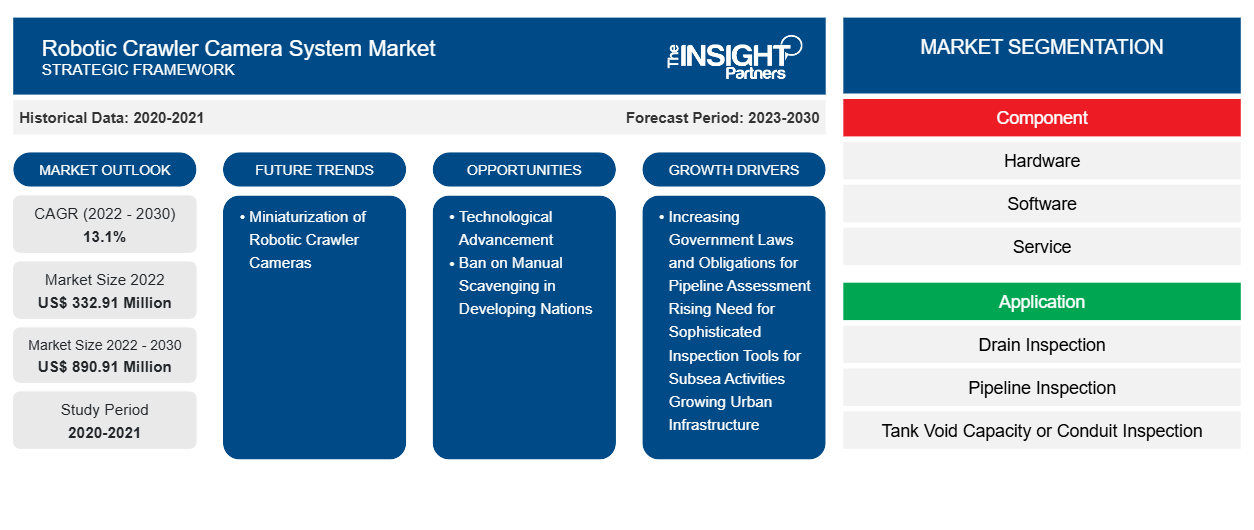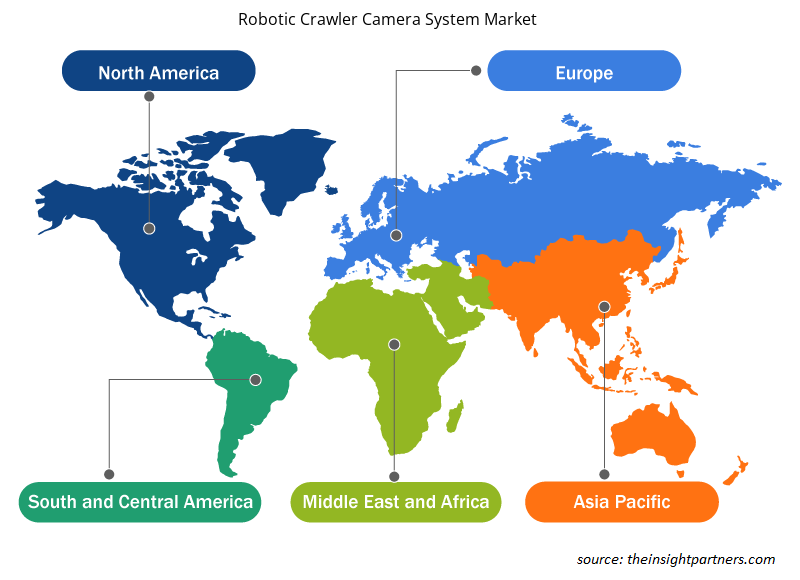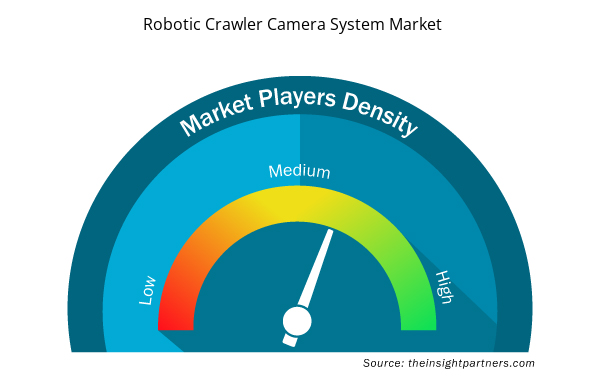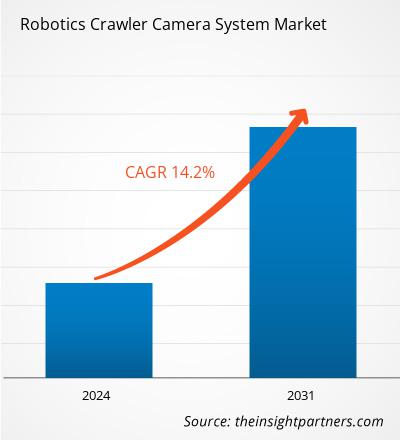2024 年机器人爬行器摄像系统市场规模价值 3.6488 亿美元,预计到 2031 年将达到 9.1813 亿美元;预计 2024 年至 2031 年的复合年增长率为 14.2%。机器人爬行器的小型化可能仍将是市场的主要趋势。
机器人爬行摄像系统市场分析
管道检查中机器人爬行摄像系统的应用激增、政府对基础设施建设的投资、对高性能系统的需求以及工业应用的扩展正在推动机器人爬行摄像系统市场的增长。制造商产品开发的激增以及对水和废水管理的不断增长的投资刺激了对这些系统的需求。不断增加的研发活动、对高性能机器人爬行摄像系统的认识不断提高、对先进功能机器人爬行摄像系统的需求不断增加以及机器人爬行器的小型化进一步促进了市场的增长。此外,技术先进的机器人爬行摄像系统的开发预计将为市场创造未来的增长机会。
机器人爬行摄像系统市场概况
机器人履带式摄像系统是机械、电子和软件系统的组合,用于检查和勘测难以到达的区域,例如管道、下水道、核反应堆和其他工业结构,同时捕获视觉数据。该系统用于探索各种地形、工业检查、下水道管线监控、管道评估和搜索救援任务。摄像机使操作员能够远程检查原本难以或危险进入的区域,使机器人履带式摄像系统成为在恶劣环境下收集视觉数据和实时观察的重要工具。该系统具有各种尺寸的可互换轮子,可灵活检查不同直径的管道。它还可以捕获和存储检查数据以供日后审查和报告。
定制此报告以满足您的需求
您可以免费定制任何报告,包括本报告的部分内容、国家级分析、Excel 数据包,以及为初创企业和大学提供优惠和折扣
机器人爬行摄像系统市场:

- 获取此报告的关键市场趋势。这个免费样品将包括数据分析,从市场趋势到估计和预测。
机器人爬行器摄像系统市场驱动因素和机遇
机器人爬行摄像系统在管道检测中的应用日益广泛
管道检查中对机器人履带式摄像系统的需求飙升可以归因于一些重要因素,包括对成本效益解决方案的需求、对改善工人和环境安全的关注以及对高性能检查系统的需求。石油和天然气、水和废水、化学和污水处理等行业正致力于采用自动化系统来检查和维护管道基础设施。机器人履带式摄像系统是一种高效、自动化的系统,需要较少的人工干预,在检查过程中具有明显的优势。这些系统配备了高清摄像头和先进的传感器,可提供实时视觉数据和对管道状况的深入了解。与传统的人工检查方法相比,机器人履带式摄像系统能够通过确保彻底检查,进入和检查难以进入的区域,例如弯道、狭窄部分和深层或水下区域。它们能够捕捉详细的视频片段和图像,使操作员能够更准确地评估缺陷;这增加了行业在检查和维护方面的采用。随着管道建设数量的不断增加以及扩建管道网络的投资不断增加,用于检查管道缺陷的机器人爬行摄像系统的应用也不断增加。
水和废水管理投资
市政当局有能力和责任为居民提供清洁的水源,并维持可持续的自然系统。近年来,由于对可持续城市发展的日益关注和对环境保护的需求不断增加,对废水管理的投资有所增加。水和废水管理投资的激增推动了对机器人爬行摄像头系统的需求,这些系统可支持市政公司管理现代废水基础设施。2023 年 10 月,加拿大政府和加拿大市政联合会宣布投资 180 万美元,用于改善魁北克的水基础设施并提供高质量的水。这笔资金用于支持魁北克各社区的六个项目。
- 拉克德拉日镇与魁北克市合作,投资 50 万美元对其曝气池处理厂进行现代化改造。该现代化改造符合省级标准,并提高了废水质量。
- 里维耶尔杜卢普市获得了 40 万美元的投资,用于安装一种新颖的技术组合,以提高其污水处理厂的产能,避免过量排放,同时满足社区和环境需求。
- 阿斯科特角市政府投资 35 万美元测试一种新型生物强化系统,该系统预计将提高其曝气池废水处理设施的处理能力;这有助于通过扩大社区发展来减少池塘中的污染物。
- 阿姆基镇投资 29,900 美元,通过建设可持续雨水管理设施来改善马塔佩迪亚河的水质;这减少了雨天和暴风雨后流入河流的径流量和悬浮颗粒物的数量。
大量资金和支持活动正在推动采用先进的解决方案,例如用于检查受污染水箱的机器人履带式摄像系统。这些系统支持市政公司减少排放、提高弹性并促进可持续性。因此,日益增长的环境问题和对改善水质的关注推动了市场增长。
机器人爬行器摄像系统市场报告细分分析
有助于得出机器人爬行摄像系统市场分析的关键部分是组件、应用和最终用户。
- 根据组件,机器人履带式摄像机系统市场分为硬件、软件和服务。硬件部分包括摄像机、履带、电缆卷筒、控制单元等。硬件部分在 2024 年占据了市场主导地位。
- 在应用方面,机器人爬行摄像系统市场分为排水检查、管道检查和油箱空腔或导管检查。管道检查领域在 2024 年占据了市场主导地位。
- 根据最终用户,机器人爬行摄像系统市场分为住宅、商业、市政和工业。工业领域在 2024 年占据市场主导地位。
机器人爬行摄像系统市场份额按地区分析
- 机器人爬行摄像系统市场分为五大区域:北美、欧洲、亚太地区 (APAC)、中东和非洲 (MEA) 以及南美和中美。2023 年欧洲占据市场主导地位,其次是北美和亚太地区。
- 在欧洲,建筑、石油和天然气以及基础设施检查等行业正在使用高分辨率机器人履带式摄像机来提高运营效率。这些系统为行业提供了一种更安全、更有效的方法来进入难以到达或危险的区域。在包括建筑在内的行业中,这些系统可用于检查建筑物、隧道和桥梁的结构完整性,从而无需人工检查员进入潜在的危险情况。石油和天然气行业利用机器人履带检查管道、储罐和海上平台,实现实时监控而不影响运营。该系统通过提供更好的高质量图片和传感器来提高数据准确性,这些图片和传感器可以检测出在人工检查过程中可能遗漏的磨损、腐蚀或堵塞。因此,扩大工业运营并专注于管道维护将推动该地区的市场增长。
机器人爬行摄像系统市场区域洞察
Insight Partners 的分析师已详细解释了预测期内影响机器人爬行摄像系统市场的区域趋势和因素。本节还讨论了北美、欧洲、亚太地区、中东和非洲以及南美和中美洲的机器人爬行摄像系统市场细分和地理位置。

- 获取机器人爬行摄像系统市场的区域特定数据
机器人爬行摄像系统市场报告范围
| 报告属性 | 细节 |
|---|---|
| 2024 年的市场规模 | 3.6488亿美元 |
| 2031 年市场规模 | 9.1813亿美元 |
| 全球复合年增长率(2024 - 2031) | 14.2% |
| 史料 | 2021-2023 |
| 预测期 | 2024-2031 |
| 涵盖的领域 | 按组件
|
| 覆盖地区和国家 | 北美
|
| 市场领导者和主要公司简介 |
|
机器人爬行器摄像系统市场参与者密度:了解其对业务动态的影响
机器人爬行器摄像系统市场正在快速增长,这得益于终端用户需求的不断增长,这些需求源于消费者偏好的不断变化、技术进步以及对产品优势的认识不断提高等因素。随着需求的增加,企业正在扩大其产品范围,进行创新以满足消费者的需求,并利用新兴趋势,从而进一步推动市场增长。
市场参与者密度是指在特定市场或行业内运营的企业或公司的分布情况。它表明在给定市场空间中,相对于其规模或总市场价值,有多少竞争对手(市场参与者)存在。
在机器人爬行器摄像系统市场运营的主要公司有:
- 查尔斯机械制造公司
- 劳施有限公司
- 明錦有限公司
- AM 工业(英国)有限公司
- CUES 公司
- 深海探险公司
免责声明:上面列出的公司没有按照任何特定顺序排列。

- 获取机器人爬行器摄像系统市场顶级关键参与者概览
机器人爬行摄像系统市场新闻和最新发展
通过收集一手和二手研究后的定性和定量数据来评估机器人爬行摄像系统市场,其中包括重要的公司出版物、协会数据和数据库。下面列出了机器人爬行摄像系统市场的一些发展情况:
- 领先的 CCTV 管道检查设备和资产检查/决策支持软件制造商 CUES 宣布推出新款 OZ4-HD 摄像机。OZ4-HD 是一款 1080p 高清平移和倾斜主线摄像机。其设计符合最高行业标准。它还提供细节丰富的视频,能够以极高的准确度检测和解决潜在的管道问题。
(来源:CUES,新闻稿,2024 年 7 月)
- Deep Trekker Inc. 宣布,根据其全球扩张战略,计划扩大其在英国和爱尔兰的业务。此外,通过改善其本地业务,该公司旨在高效地为客户提供服务。
(来源:Deep Trekker Inc,新闻稿,2024 年 1 月)
机器人爬行器摄像系统市场报告覆盖范围和交付成果
“机器人爬行摄像系统市场规模和预测(2021-2031)”对市场进行了详细的分析,涵盖了以下领域:
- 机器人爬行摄像系统市场规模及全球、区域和国家层面所有关键细分市场的预测
- 机器人爬行摄像系统市场趋势,以及驱动因素、限制因素和关键机遇等市场动态
- 详细的 PEST 和 SWOT 分析
- 机器人爬行摄像系统市场分析涵盖关键市场趋势、全球和区域框架、主要参与者、法规和最新市场发展
- 行业格局和竞争分析,涵盖市场集中度、热图分析、知名参与者以及机器人爬行摄像系统市场的最新发展
- 详细的公司简介
- 历史分析(2 年)、基准年、预测(7 年)及复合年增长率
- PEST 和 SWOT 分析
- 市场规模价值/数量 - 全球、区域、国家
- 行业和竞争格局
- Excel 数据集


- Playout Solutions Market
- Smart Locks Market
- Architecture Software Market
- Advanced Planning and Scheduling Software Market
- Visualization and 3D Rendering Software Market
- Adaptive Traffic Control System Market
- MEMS Foundry Market
- Biopharmaceutical Contract Manufacturing Market
- Medical Second Opinion Market
- Hummus Market

Report Coverage
Revenue forecast, Company Analysis, Industry landscape, Growth factors, and Trends

Segment Covered
This text is related
to segments covered.

Regional Scope
North America, Europe, Asia Pacific, Middle East & Africa, South & Central America

Country Scope
This text is related
to country scope.
常见问题
The global robotics crawler camera system market is estimated to register a CAGR of 14.2% during the forecast period 2024–2031.
The global robotics crawler camera system market is expected to reach US$ 918.13 million by 2031.
Europe dominated the robotics crawler camera system market in 2024.
Growing adoption of robotics crawler camera systems in pipeline inspection; demand for high-performance systems; and investment in water and wastewater management are the major factors that propel the global robotics crawler camera system market.
Miniaturization of robotic crawler and ban on manual scavenging in developing nations drives to play a significant role in the global robotics crawler camera system market in the coming years.
The key players holding majority shares in the global robotics crawler camera system market are The Charles Machine Works Inc; Rausch GmbH; Minicam Limited; AM Industrial (UK) Ltd; CUES Inc; Deep Trekker Inc; Previan Technologies, Inc.; Kummert GmbH; iPEK International GmbH; Inspector Systems GmbH; Asian Contec Ltd; Nexxis; Wuhan Easy-Sight Technology Co., Ltd; Aerica Engineering Private Limited; and Spartan Tool LLC.
Trends and growth analysis reports related to Electronics and Semiconductor : READ MORE..
The List of Companies - Robotic Crawler Camera System Market
- The Charles Machine Works Inc
- Rausch GmbH
- Minicam Limited
- AM Industrial (UK) Ltd
- CUES Inc
- Deep Trekker Inc
- Eddyfi Technologies
- Kummert GmbH
- iPEK International GmbH
- Inspector Systems GmbH
- Asian Contec Ltd
- Nexxis
- Wuhan Easy-Sight Technology Co., Ltd
- Aerica Engineering Private Limited
- Spartan Tool LLC
The Insight Partners performs research in 4 major stages: Data Collection & Secondary Research, Primary Research, Data Analysis and Data Triangulation & Final Review.
- Data Collection and Secondary Research:
As a market research and consulting firm operating from a decade, we have published and advised several client across the globe. First step for any study will start with an assessment of currently available data and insights from existing reports. Further, historical and current market information is collected from Investor Presentations, Annual Reports, SEC Filings, etc., and other information related to company’s performance and market positioning are gathered from Paid Databases (Factiva, Hoovers, and Reuters) and various other publications available in public domain.
Several associations trade associates, technical forums, institutes, societies and organization are accessed to gain technical as well as market related insights through their publications such as research papers, blogs and press releases related to the studies are referred to get cues about the market. Further, white papers, journals, magazines, and other news articles published in last 3 years are scrutinized and analyzed to understand the current market trends.
- Primary Research:
The primarily interview analysis comprise of data obtained from industry participants interview and answers to survey questions gathered by in-house primary team.
For primary research, interviews are conducted with industry experts/CEOs/Marketing Managers/VPs/Subject Matter Experts from both demand and supply side to get a 360-degree view of the market. The primary team conducts several interviews based on the complexity of the markets to understand the various market trends and dynamics which makes research more credible and precise.
A typical research interview fulfils the following functions:
- Provides first-hand information on the market size, market trends, growth trends, competitive landscape, and outlook
- Validates and strengthens in-house secondary research findings
- Develops the analysis team’s expertise and market understanding
Primary research involves email interactions and telephone interviews for each market, category, segment, and sub-segment across geographies. The participants who typically take part in such a process include, but are not limited to:
- Industry participants: VPs, business development managers, market intelligence managers and national sales managers
- Outside experts: Valuation experts, research analysts and key opinion leaders specializing in the electronics and semiconductor industry.
Below is the breakup of our primary respondents by company, designation, and region:

Once we receive the confirmation from primary research sources or primary respondents, we finalize the base year market estimation and forecast the data as per the macroeconomic and microeconomic factors assessed during data collection.
- Data Analysis:
Once data is validated through both secondary as well as primary respondents, we finalize the market estimations by hypothesis formulation and factor analysis at regional and country level.
- Macro-Economic Factor Analysis:
We analyse macroeconomic indicators such the gross domestic product (GDP), increase in the demand for goods and services across industries, technological advancement, regional economic growth, governmental policies, the influence of COVID-19, PEST analysis, and other aspects. This analysis aids in setting benchmarks for various nations/regions and approximating market splits. Additionally, the general trend of the aforementioned components aid in determining the market's development possibilities.
- Country Level Data:
Various factors that are especially aligned to the country are taken into account to determine the market size for a certain area and country, including the presence of vendors, such as headquarters and offices, the country's GDP, demand patterns, and industry growth. To comprehend the market dynamics for the nation, a number of growth variables, inhibitors, application areas, and current market trends are researched. The aforementioned elements aid in determining the country's overall market's growth potential.
- Company Profile:
The “Table of Contents” is formulated by listing and analyzing more than 25 - 30 companies operating in the market ecosystem across geographies. However, we profile only 10 companies as a standard practice in our syndicate reports. These 10 companies comprise leading, emerging, and regional players. Nonetheless, our analysis is not restricted to the 10 listed companies, we also analyze other companies present in the market to develop a holistic view and understand the prevailing trends. The “Company Profiles” section in the report covers key facts, business description, products & services, financial information, SWOT analysis, and key developments. The financial information presented is extracted from the annual reports and official documents of the publicly listed companies. Upon collecting the information for the sections of respective companies, we verify them via various primary sources and then compile the data in respective company profiles. The company level information helps us in deriving the base number as well as in forecasting the market size.
- Developing Base Number:
Aggregation of sales statistics (2020-2022) and macro-economic factor, and other secondary and primary research insights are utilized to arrive at base number and related market shares for 2022. The data gaps are identified in this step and relevant market data is analyzed, collected from paid primary interviews or databases. On finalizing the base year market size, forecasts are developed on the basis of macro-economic, industry and market growth factors and company level analysis.
- Data Triangulation and Final Review:
The market findings and base year market size calculations are validated from supply as well as demand side. Demand side validations are based on macro-economic factor analysis and benchmarks for respective regions and countries. In case of supply side validations, revenues of major companies are estimated (in case not available) based on industry benchmark, approximate number of employees, product portfolio, and primary interviews revenues are gathered. Further revenue from target product/service segment is assessed to avoid overshooting of market statistics. In case of heavy deviations between supply and demand side values, all thes steps are repeated to achieve synchronization.
We follow an iterative model, wherein we share our research findings with Subject Matter Experts (SME’s) and Key Opinion Leaders (KOLs) until consensus view of the market is not formulated – this model negates any drastic deviation in the opinions of experts. Only validated and universally acceptable research findings are quoted in our reports.
We have important check points that we use to validate our research findings – which we call – data triangulation, where we validate the information, we generate from secondary sources with primary interviews and then we re-validate with our internal data bases and Subject matter experts. This comprehensive model enables us to deliver high quality, reliable data in shortest possible time.

 获取此报告的免费样本
获取此报告的免费样本